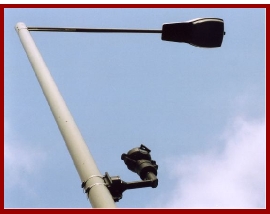| ||||||||||||||||||||||||||||
 | ||||||||||||||||||||||||||||
Welcome to the | ||||||||||||||||||||||||||||
 | ||||||||||||||||||||||||||||
CCTV CameraPerformance - Sensitivity
It has to be said that the Electronic Iris function, particularly on better quality cameras, is generally far more appropriate for Colour cameras. If the technique is used on Black and White units, particularly under sunlit conditions, any bright reflections (which are inherently very high in Infra Red content) may cause distracting effects on the picture, such as 'vertical smearing' (white lines that appear top to bottom on the picture, caused by the overloaded pixels 'bleeding' an electrical charge into the neighbouring elements), and 'blooming' (an over representation of a point of light, which appears on screen as an indistinct disc). Although these effects are irritating, and indeed equally possible with any camera / lens combination, they will generally not cause any lasting damage to a solid state imager, although the same cannot always be said for a conventional Cathode Ray Tube (CRT) monitor! One final point on camera exposure control; apart from the Electronic Iris function, there are also many cameras which offer a manual 'shutter' facility. Unlike EI, the camera can be set using a series of normally hidden DIP switches, to a specific image sampling speed, such as 1/250th or 1/5000th of a second; here the speed will not vary automatically but will remain fixed on the programmed setting. This function is rarely used on security CCTV cameras, but is generally of more use in process monitoring or scientific lab. applications, where it can be used to slow down or stop moving items, or measure large body velocities. In practice of course, under bright light conditions, the same effect of changing the image sampling speed can be achieved using Electronic Iris, simply by varying the lens aperture setting:- | ||||||||||||||||||||||||||||
 | ||||||||||||||||||||||||||||
IMPORTANT: No material may be reproduced, copied or redistributed from this site, © doktorjon.co.uk 2004 - 2008 Homepage...:...Gateway...:...Technical Gateway....:....Quickfind Index....:....Equipment Directory | ||||||||||||||||||||||||||||

